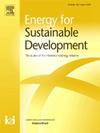安达曼和尼科巴群岛的农业发电:评估可持续发展的地理空间潜力
IF 4.9
2区 工程技术
Q2 ENERGY & FUELS
引用次数: 0
摘要
本研究探讨了农业发电(AV)作为安达曼和尼科巴群岛能源生产和有效土地利用的解决方案,旨在减少对柴油发电的依赖。利用GIS,该研究确定1422.28公顷为高度适合,9648.54公顷为中等适合的AV系统。这意味着潜在的4428.328兆瓦的电力,大约是岛屿当前消耗的63倍,仅利用总陆地面积的1.34%就可以实现。该分析还提出了PVsyst模拟和LCOE分析的财务观点,显示单面硅多晶技术最具成本效益,地面安装为24.07美元/兆瓦时(1美元= 86.70卢比),高架AV系统为31.08美元/兆瓦时;CDTE光伏技术的比产值最高,达到1696.90 kWh/kWp/年。敏感性分析表明,资本成本是对LCOE影响最大的决定因素,因为资本成本的±50%的变化导致LCOE的±48 - 49%的变化。文献表明,AV可以通过减少作物热胁迫和改善土壤湿度来提高土地生产力,这反过来又可以使豆类,蔬菜和水果等受益。研究结果表明,AV系统可以显着改善能源安全,为农民提供经济效益,并支持A&;N群岛的可持续发展目标(sdg) 2(零饥饿),7(负担得起的清洁能源),13(气候行动)和15(陆地上的生命)。本文章由计算机程序翻译,如有差异,请以英文原文为准。
Agrivoltaics in the Andaman and Nicobar Islands: Assessing the geo-spatial potential for sustainable development
This study explores agrivoltaics (AV) as a solution for energy generation and efficient land use in the Andaman and Nicobar Islands, aiming to reduce dependence on diesel power. Using GIS, the study identified 1422.28 ha as highly suitable and 9648.54 ha as moderately suitable for AV systems. This translates to a potential 4428.328 MWP of power, roughly 63 times the islands' current consumption, achievable by utilizing only 1.34 % of the total land area. The analysis also presented a financial view with PVsyst simulations and LCOE analyses revealing monofacial Si Poly-crystalline technology has been most cost-effective at $24.07/MWh (1$ = 86.70₹) for ground-mounted and $31.08/MWh for elevated AV systems; and the CDTE PV technology, which had the highest Specific production values at 1696.90 kWh/kWp/year. A sensitivity analysis indicated that the capital cost is the most influential determinant on LCOE because ±50 % changes in capital cost resulted in a ±48–49 % change effort on LCOE. Literature suggests that AV can be advantageous to land productivity by decreasing crop heat stress and improving soil moisture which, in turn, can benefit pulses, vegetables, and fruit as examples. The findings suggest that AV systems can significantly improve energy security, provide financial benefits to farmers, and support Sustainable Development Goals (SDGs) 2 (Zero Hunger), 7 (Affordable and Clean Energy), 13 (Climate Action), and 15 (Life on Land) in the A&N Islands.
求助全文
通过发布文献求助,成功后即可免费获取论文全文。
去求助
来源期刊

Energy for Sustainable Development
ENERGY & FUELS-ENERGY & FUELS
CiteScore
8.10
自引率
9.10%
发文量
187
审稿时长
6-12 weeks
期刊介绍:
Published on behalf of the International Energy Initiative, Energy for Sustainable Development is the journal for decision makers, managers, consultants, policy makers, planners and researchers in both government and non-government organizations. It publishes original research and reviews about energy in developing countries, sustainable development, energy resources, technologies, policies and interactions.
 求助内容:
求助内容: 应助结果提醒方式:
应助结果提醒方式:


